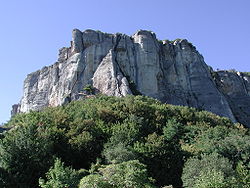Calcarenite

Calcarenite is a type of limestone that is composed predominantly, more than 50 percent, of detrital (transported) sand-size (0.0625 to 2 mm in diameter), carbonate grains. The grains consist of sand-size grains of either corals, shells, ooids, intraclasts, pellets, fragments of older limestones and dolomites, other carbonate grains, or some combination of these. Calcarenite is the carbonate equivalent of a sandstone. The term calcarenite was originally proposed in 1903 by Grabau[1][2] as a part of his calcilutite, calcarenite and calcirudite carbonate classification system based upon the size of the detrital grains composing a limestone.[3][4] Calcarenites can accumulate in a wide variety of marine and non-marine environments. They can consist of grains of carbonate that have accumulated either as coastal sand dunes (eolianites), beaches, offshore bars and shoals, turbidites, or other depositional settings.[3][5]
References
- ^ Grabau, A.W. (1903) Paleozoic coral reefs. Geological Society of America Bulletin. vol. 14, pp. 337-352.
- ^ Grabau, A.W. (1904) On the classification of sedimentary rocks. American Geologist. vol. 33, pp. 228-247.
- ^ ISBN 978-3-540-22016-9
- ISBN 0-922152-76-4
- ISBN 978-0-89181-310-1
See also
- Calcilutite – Limestone that is composed of predominantly clay-size or clay and silt-size grains
- Calcisiltite – Type of limestone
- Calcirudite – sedimentary rock
